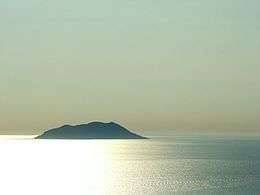Svetac
| Native name: <span class="nickname" ">Štondrija Nickname: Svetac | |
|---|---|
 Svetac from Komiža | |
|
| |
| Geography | |
| Location | Adriatic Sea |
| Coordinates | Coordinates: 43°01′33″N 15°44′56″E / 43.0257402900°N 15.7489017300°E |
| Archipelago | Vis archipelago |
| Area | 4.19 km2 (1.62 sq mi) |
| Highest elevation | 316 m (1,037 ft) |
| Highest point | Kosa |
| Administration | |
| County | Split-Dalmatia |
Sveti Andrija (Croatian pronunciation: [svȇtī ǎndrija], meaning Saint Andrew), often called Svetac (Croatian pronunciation: [sʋěːtat͡s], meaning saint) is an island in the Croatian part of the Adriatic Sea. It is situated 14 nautical miles (26 km) from Komiža (a town on the island of Vis). It is uninhabited, although it used to have permanent residents. Remains of Byzantine origin can be found on the island. The population census on Svetac from 1951 was around 60, most of these people are now deceased. All were members of Zanki family who came on the island 260 years ago (in the mid-18th century). The last one of the group who lived there all year round was Antonija Zanki, an elderly woman who died in 2000. Now members of Zanki family effectively live there four to six months a year, still keeping up the houses of their grandfathers, fishing, making famous red wine and olive oil. Most of members of Zanki family who own this, biggest private island in Adriatic, live in Komiža now (14 nm east). Taking the fact that island is in open seas, without any natural protected bay, gives even greater respect to members of this family who managed to survive there for centuries, and furthermore created a special kind of living, especially today.[1]
Near the west coast of the island there is the small island of Kamik, and farther on the open sea there is the volcanic island called Jabuka. About 2.5 kilometres (1.3 nautical miles)[2] to the southeast there is the small volcanic island of Brusnik.
The island is a breeding ground for a small number of Eleonora's falcons, a rare bird with only c. 80 nesting pairs estimated to live in Croatia.[3] The falcons migrate to Madagascar every September and return to their nests in April.[4]
References
- ↑ A tip about the island on dalmatia.hr
- ↑ Duplančić Leder, Tea; Ujević, Tin; Čala, Mendi (June 2004). "Coastline lengths and areas of islands in the Croatian part of the Adriatic Sea determined from the topographic maps at the scale of 1 : 25 000" (PDF). Geoadria. Zadar. 9 (1): 5–32. Retrieved 2011-01-21.
- ↑ "Ugroženog Eleonorina sokola na Svecu prati nadzorna kamera". Slobodna Dalmacija (in Croatian). 24 July 2012. Retrieved 25 July 2012.
- ↑ http://bib.irb.hr/datoteka/348047.TEKST_LEKTORIRAN.rtf (Croatian)
- Mithad Kozličić, Josip Faričić: "The Significance of Sv. Andrija Island (Svetac) on a Sailing Route Across the Adriatic Presented on Old Geographical Maps"